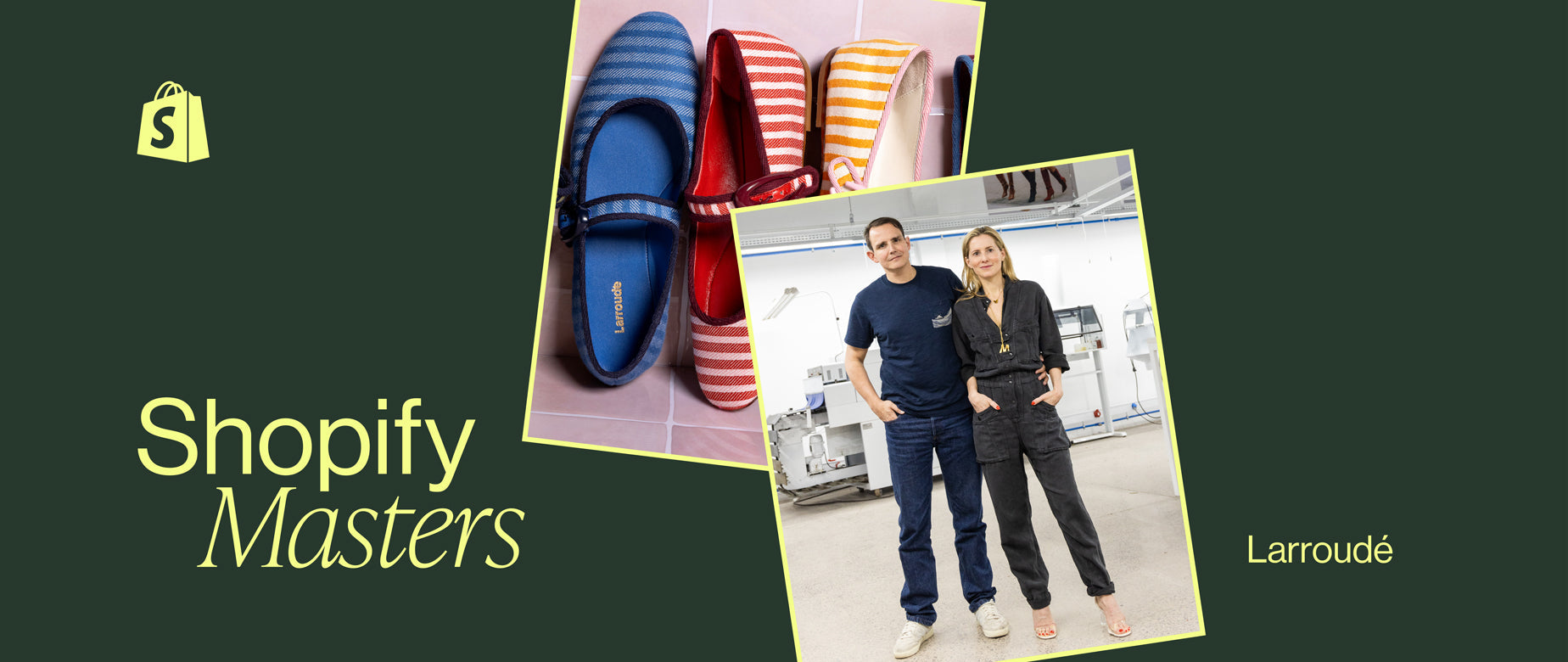Launching a fashion brand in the middle of the pandemic might sound like the worst timing possible. But for Marina and Ricardo Larroudé, necessity turned into opportunity. With $4,000, a Shopify site, and a clear vision, the couple built Larroudé into one of Fast Company’s Most Innovative Companies and Footwear News’s Brand of the Year.
Learn how the founders bootstrapped their way to nine-digit revenue, why vertical integration gave them an edge, how their direct-to-demand model rethinks fast fashion, and what it’s like to scale a business with your spouse.
Starting small and celebrating every milestone
When launching Larroudé, Marina and Ricardo didn’t raise a big round of funding. Instead, they started with what they had and tested everything in small, scrappy ways. Marina remembers, “In our second month of Larroudé, we sold $5,000 and we were celebrating. And now we do that in a matter of minutes, and we are still celebrating.” The couple had a Shopify site, samples, seed money from their savings, and each other. They scaled up their production only when they could prove demand.
That bootstrap mentality shaped their approach then and still fuels how they work today. “We started doing things gradually,” Ricardo says. “Trying things doesn’t cost that much money. But then when you find something that really works, then you put the money behind it.”
For other founders, the lesson is in patience and discipline: resist the urge to overspend upfront, validate demand first, and let each milestone guide the next investment.

Why vertical integration was worth the leap
As orders grew, outsourced factories couldn’t keep up with Larroudé’s timelines. “I would call the factory and say, ‘I need 600 more.’ They would say, ‘OK, in 120 days,’” Ricardo recalls. Waiting months meant missing the season entirely, and it quickly became clear that relying on outside partners was unsustainable.
The fix was drastic but practical: build their own factory in Brazil. When Ricardo ran the numbers, he realized that the cost of one large outsourced order was about the same as buying used machines outright. By setting up their own facility, the team could bypass intermediaries, hire directly, and keep production in sync with demand. As he puts it, “I just buy a bunch of leather and I sell shoes.”
Taking production in-house gave Larroudé the speed to replenish bestsellers within weeks, tighter control over quality, and the flexibility to experiment with new designs on short notice. In an industry where long lead times can derail momentum, vertical integration became the company’s competitive edge.

Reframing fashion with a direct-to-demand model
Ricardo likens traditional fashion to grocery stores that overstock perishable food and then discount it as it spoils. To avoid that waste, Larroudé produces only what customers order. “Fashion is a perishable item,” he explains. His team built a system more like a pizzeria: they keep the “dough and toppings” ready, then make what’s ordered on demand.
Customers are invited to preorder upcoming collections, often at a discount, which gives the company immediate insight into which styles are worth scaling. Marina described how quickly they can act on this data: “If a client really like[s] a certain type of shoe, we go and we design more shoes that are similar to that, and we are able to launch those new shoes … in a week from that day.”
This model minimizes unsold inventory, lets the company respond to real-time demand, and creates anticipation around every release. For shoppers, the experience feels less like buying off the rack and more like participating in the creative process.

Building a company and marriage side by side
Running a fast-growing brand as a married couple comes with unique pressures, but Marina and Ricardo say the key is honesty. “We have all the very hard conversations,” Marina says, noting that nothing is left unsaid between them. She explained that while they are both cofounders, their day-to-day roles are distinct. Ricardo leads as CEO while she drives the brand’s creative direction.
Ricardo emphasizes that their relationship works because of constant communication and mutual trust. “I think we’re best friends also,” he says, adding that clearly defined responsibilities are just as important for the company as they are for the marriage. For employees, knowing where each founder shines helps create alignment across teams.
By dividing responsibilities and staying united on vision, the Larroudés built a foundation strong enough to handle hypergrowth and the demands of leading hundreds of employees. Their experience shows how co-founder partnerships—whether between spouses or not—benefit from radical honesty, trust, and role clarity.
Larroudé has grown from a dining room startup to a 550-person company with a nine-digit revenue. Its journey shows that with resourcefulness, vertical integration, customer-led production, and a strong partnership, it’s possible to scale faster and smarter—even in the toughest of times.
For more insight into how Larroudé is able to stand out in the crowded footwear industry, check out the full interview on Shopify Masters.




